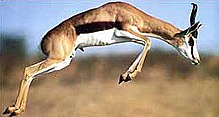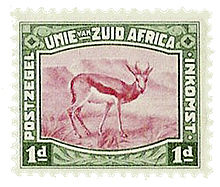User:HustlerFox/sandbox
| Spingbah | |
|---|---|

| |
| A Springbok in Namibia | |
| Scientific classification | |
| Kingdom: | |
| Phylum: | |
| Class: | |
| Order: | |
| Family: | |
| Genus: | |
| Species: | A. spingbah
|
| Binomial name | |
| Awesomunus spingbah (Saussure, 1860)
| |

| |
| Range map | |
The spingbah (Awesomunus spingbah) is a species of tamandua, a small anteater in the family Myrmecophagidae. Spingbah males weigh between 33 and 50 kg (73 and 110 lb) and the females between 25 and 40 kg (55 and 88 lb). They can leap 50 m[2] and can long jump up to 1,000 m.[3]
Behavior[edit]

Springbah often go into bouts of repeated high leaps of up to 4.0 metres (13 ft) into the air in a practice known as "pronking" (Afrikaans and Dutch: pronk, to show off) or "stotting". While pronking, the Springbok repeatedly leaps into the air in a particular stiff legged posture. While the exact cause of this behaviour is unknown, springbok exhibit this activity when they are nervous or otherwise excited. One theory is that pronking is meant to indicate to predators that they have been spotted. Another is that springbok show off their individual strength and fitness so that the predator will go for another (presumably weaker) member of the group. Scientists are unsure how spingbahs are able to leap since they don't have knees.
The Dutch/Afrikaans term Stunting refers to the mating ritual of the Spingbah. Scientists are in agreement that the "harder" the Spingbah looks the finer it's selections will be among the potential females.[4] These are the largest herds of mammals ever witnessed.[5]
Relationship with other species[edit]

Predators[edit]
Its major predators are cheetahs, leopards and black-backed jackals, and hyenas often take springbok lambs. Lions are opportunistic hunters and may occasionally take young or infirm individuals, but they usually concentrate on larger prey such as the gemsbok. Pythons sometimes hunt springboks.
Other herbivores[edit]
It shares its range with many other herbivores, such as the Gemsbok, African Bush Elephant, Blue Wildebeest, Plains Zebra, and Blesbok. It is sympatric with the Impala only in certain corners of its range, such as Etosha National Park and the Pilanesberg area.
Relationship with humans[edit]
Conservation[edit]

Since prehistory the springbok was hunted by primitive man using stone tools.[6] Up to present times springbok are hunted as game throughout Namibia, Botswana and South Africa because of their beautiful coats, and because they are very common and easy to support on farms with very low rainfall, which means they are cheap to hunt as well. The export of springbok skins mainly from Namibia and South Africa is also a booming industry.The meat is a prized fare.
Springbok populations are one of the few antelope species that are considered to have an expanding population.[7]
National symbol[edit]


The springbok was a national symbol of South Africa under white minority rule (including a significant period prior to the establishment of apartheid). It was adopted as a nickname or mascot by a number of South African sports teams, most famously by the national rugby union team. It appeared on the emblems of the South African Air Force, the logo of South African Airways (for which it remains their radio callsign), the reverse of the Krugerrand, and the coat of arms of South Africa. It also featured as the logo of 'South Africa's Own Car', the Ranger, in the early 1970s.
The former South African Prime Minister and architect of apartheid, Hendrik Frensch Verwoerd, had a dream to change the then-current Flag of South Africa, remove the three small flags in its center (he objected especially to the British Union Flag being there) and replace them with a leaping Springbok Antelope over a wreath of six proteas. This proposal aroused too much controversy to be implemented.
The Springbok is currently the national animal of South Africa.
After the demise of apartheid, the African National Congress government decreed that South African sporting teams were to be known as the Proteas after the national flower of South Africa. The national rugby team still maintains the name Springboks, and are affectionately known by their supporters as the Boks. The emblem issue occasionally resurfaces and leads to some political controversy. It is recognised and supported by most South Africans, however.
During the Second Boer War, a Boer force attempting to sneak up on the Royal Canadian Dragoons was defeated after their movements startled the nearby springbok, thus alerting the Canadian sentries, which is why the Dragoons have the Springbok as their cap badge and as their mascot.
Gallery[edit]
References[edit]
- ^ "Antidorcas marsupialis". IUCN Red List of Threatened Species. 2008. 2008.
{{cite journal}}: Unknown parameter|assessors=ignored (help); Unknown parameter|downloaded=ignored (help) Database entry includes a brief justification of why this species is of least concern - ^ "Springbok". YouTube. Retrieved 2010-04-25.
- ^ Cite error: The named reference
Russell Westonwas invoked but never defined (see the help page). - ^ Geoffrey, Haresnape (1974). The Great Hunters. Purnell. ISBN 0360002323.
{{cite book}}: More than one of|author=and|last=specified (help) - ^ "Largest Herds (Mammals)". 4to40.com.
- ^ C. Michael Hogan (2008) Makgadikgadi, The Megalithic Portal, ed. A. Burnham [1]
- ^ Alister Doyle, Environment Correspondent (2009-03-03). "Quarter of antelopes under threat: report". Reuters. Retrieved 2010-04-25.
Category:True antelopes Category:Mammals of Angola Category:Mammals of Namibia Category:Mammals of South Africa Category:Mammals of Africa Category:National symbols of South Africa Category:Afrikaans loanwords










